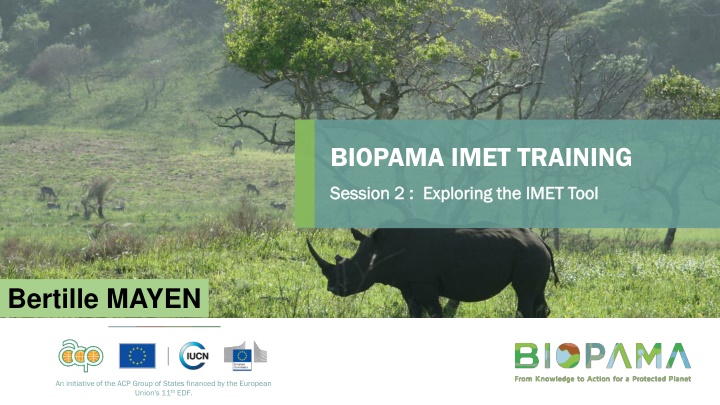BIOPAMA IMET TRAINING
The IMET tool is an integral part of the BIOPAMA program initiated in 2011 and supported by the EU. It aims to address biodiversity threats in African, Caribbean & Pacific countries while reducing poverty. The tool goes beyond assessing management effectiveness and supports PA planning, decision-making, monitoring, and evaluation. Learn about the tool's history, key features, conceptual basis, and modules. Explore how IMET ensures good PA management and supports stakeholders in making informed decisions.
Download Presentation

Please find below an Image/Link to download the presentation.
The content on the website is provided AS IS for your information and personal use only. It may not be sold, licensed, or shared on other websites without obtaining consent from the author.If you encounter any issues during the download, it is possible that the publisher has removed the file from their server.
You are allowed to download the files provided on this website for personal or commercial use, subject to the condition that they are used lawfully. All files are the property of their respective owners.
The content on the website is provided AS IS for your information and personal use only. It may not be sold, licensed, or shared on other websites without obtaining consent from the author.
E N D
Presentation Transcript
BIOPAMA IMET TRAINING Session 2 : Session 2 : Exploring Exploring the the IMET Tool IMET Tool Bertille MAYEN An initiative of the ACP Group of States financed by the European Union's 11thEDF.
INTRODUCTION 2 IMET Why a new tool? For who? For what? Main features? LEARNING OBJECTIVES At the end of the session, participants will be familiar with : Brief history of IMET development process; IMET usefulness / purpose; Key characteristics of the IMET form
Brief history of IMET development process IMET is part of the wider BIOPAMA programme. Started in 2011, it will run until2023 with funds from the EU. IMET aims to address threats related to biodiversity in African, Caribbean & Pacific countries while reducing poverty in communities living in and around PAs. Implemented by IUCN, EU's Joint ResearchCentre and Regional Observatories. Some key milestones 2013: Central african countries requested a tool that can give a clear picture of the status of a PA management effectivenes and also help in decision making during the Phase 1 of BIOPAMA; 2014-2015: Pilot and development of the first version in excel format in Central Africa and others countries. 2015 : Training of 25 coaches from 11 countries in Central and West Africa (using the version in the excel format ) 2016: Roll out the first IMET campaigns in 100 PAs located in 15 countries. The process is ongoing : developing new modules, improving the tool
IMET usefulness / purpose IMET goes way beyond assessing management effectiveness, it s a comprehensive tool to support PA planning, to support decision making, to regularly conduct monitoring & evaluation. Since its creation, the IMET has been used in various PAs across African, Asian and Caribbean countries . The graph outlines process for applying the IMET.
IMET is useful in ensuring the good management of a PA; The conceptual basis for assessing management effectiveness is grounded in the IUCN framework comprising six elements of an adaptive management cycle. The framework: provides a basis for assessment; gives guidance about what to assess & contains broad criteria for assessment, presents key elements for designing a PA management objectives , monitoring the trends & evaluating the way in which the PA is managed.
Composed of 3 modules that can be completed online oroffline: IMET Key Features Evaluation of the state of the intervention context , Assessment of PA management effectiveness (Visualization of the produced elements) Analyses and reporting tosupport decision-making The form should be completed in a workshop set up withstakeholders; Through BIOPAMA, the IMET process is supported bycoaches who train PA managers and assist in completing theform; IMET takes into account othermethodologies (METT and EoH) and enables PA Managers to establish functional links between differentlevels of management - from the site to landscape andecosystem, regional or national network. Purpose Contribute to improving protected area management andmeet conservation targets Challenge IMET original version has evolved to the current Version 2.08. The developers of the tool are still working to improve the IMET experience based on practitioners feedback Strengths The tool goes beyond management effectiveness and supports PA planning & monitoring. It provides automatic visualization of data collected, gives a quick overview of results . In addition the online form allows for centralized data collection thuscontributes to improved reporting on PAs
EVALUATION OF THE STATE OF A PA INTERVENTION CONTEXT To evaluate the intervention context of a PA , one has to look at the following 7 areas of the PA CTX.1. General information about the protected area CTX.2. Surface area, limits and shape index, level of control of the PA CTX.3. Human, financial and material resources of the protected area CTX.4. Key aspects of the land and marine protected areas: i) flagship, threatened, endemic species; ii) habitats; iii) changes in land cover; and iv) resource management CTX.5. Pressures and threats to the protected area CTX.6. Climate change and conservation CTX.7 Ecosystem services and dependence of the protected area communities on these services With regard to the management context, data will be collected on the 4 main areas bellow C1 Values and significance ; C1.1 Governance; C1.2 Classifications; C1.3 Key species; C1.4 Habitats; C1.5 Climate change; C1.6 Ecosystem services C2 Constraint or support by external political and civil environment C3 Threats C4 Determining conservation objectives and indicators that match the protected area management
IMET Form : IMET Form : Results Results Visualisation Visualisation
THANK YOU The Biodiversity and Protected Areas Management Programme (BIOPAMA) is an initiative of the ACP Group of States financed by the European Union's 11th EDF.























